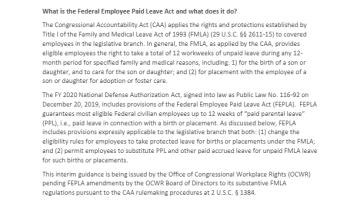What is the Federal Employee Paid Leave Act and what does it do?
The Congressional Accountability Act (CAA) applies the rights and protections established by Title I of the Family and Medical Leave Act of 1993 (FMLA) (29 U.S.C. §§ 2611-15) to covered employees in the legislative branch. In general, the FMLA, as applied by the CAA, provides eligible employees the right to take a total of 12 workweeks of unpaid leave during any 12- month period for specified family and medical reasons, including 1) for the birth of a son or daughter, and to care for the son or daughter; and (2) for placement with the employee of a son or daughter for adoption or foster care. The FY 2020 National Defense Authorization Act, signed into law as Public Law No. 116-92 on December 20, 2019, includes provisions of the Federal Employee Paid Leave Act (FEPLA). FEPLA guarantees most eligible Federal civilian employees up to 12 weeks of “paid parental leave” (PPL), i.e., paid leave in connection with a birth or placement. As discussed below, FEPLA includes provisions expressly applicable to the legislative branch that both: (1) change the eligibility rules for employees to take protected leave for births or placements under the FMLA; and (2) permit employees to substitute PPL and other paid accrued leave for unpaid FMLA leave for such births or placements. This interim guidance is being issued by the Office of Congressional Workplace Rights (OCWR) pending FEPLA amendments by the OCWR Board of Directors to its substantive FMLA regulations pursuant to the CAA rulemaking procedures at 2 U.S.C. § 1384.
When are the Paid Parental Leave provisions of the FEPLA effective?
Section 7603(c) of FEPLA provides that the amendments to the CAA concerning PPL are not effective with respect to any birth or placement for adoption or foster care occurring before October 1, 2020. Thus, by law, PPL will be available to covered employees only in connection with a birth or placement that occurs on or after October 1, 2020.
